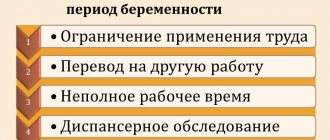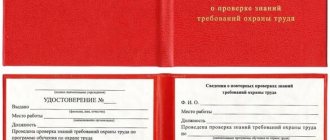Home / Labor Law / Personnel Management / Personnel Records
Back
Published: 05/09/2017
Reading time: 7 min
0
2845
The efficiency of any enterprise is determined based on an assessment of the labor productivity of personnel involved in the production process. This universal criterion allows employers to control basic indicators that reflect the real situation at the enterprise.
It becomes possible to compare different groups of workers employed in the production sector and plan the performance indicators of their work activities for the near future. The success of companies or enterprises largely depends on the correctness of productivity calculations.
- Definition of the concept
- Basic indicators
- Calculation methods and examples for them
- Why do you need to calculate labor productivity?
Dear readers! To solve your problem, call hotline 8 or ask a question on the website. It's free.
Ask a question And the versatility of this parameter allows you to work both with statistics in a narrow area (for example, in assessing the work of a separate workshop), and with data received from the entire region, country, or even a group of countries.
Key labor productivity indicators
The use of the indicator under consideration is effective when analyzing the work of not only individual enterprises, but also entire regions of the country, industries and agriculture, or the entire state economy as a whole.
Labor productivity is an indicator characterizing the effectiveness of work per unit of resource spent.
Here the result can be considered:
- volume of products produced;
- services provided;
- completed work;
- added value;
- price;
- quantity;
- quality.
Resources may include:
- time;
- cost unit;
- amount of work completed;
- used materials;
- Earth;
- energy;
- technologies.
This concept can be viewed from two points of view:
- We can talk about productivity, which is determined by the ratio of the result obtained and the effort spent on it.
- When talking about efficiency, the result is assessed in relation to a unit of resources expended or in relation to one working person.
Summary
To summarize, we can say that a formula such as labor productivity can provide not only accurate data on the efficiency of using working capital, but also have a significant impact on the process of generating a new development strategy for the company, determining its future goals and developing ways to implement it.
The indicator can be used both for internal purposes of the company, assessing its own capabilities, and for auditing its competitors.
How to correctly calculate labor productivity
The classic way to determine this is to divide the volume of products produced by the time spent producing them:
B = O / T
The following notation is used in this formula:
- B is the desired value;
- O - volume of products produced;
- T is the period of time in relation to which productivity is determined.
You can also calculate using another more accurate formula. It additionally takes into account the number of working employees and whether there was downtime:
P = (O * (1 - Kpr)) / (T1 * H)
In this formula:
- T1 - denotes labor costs per 1 employee;
- H — represents the number of employees;
- Kpr is a coefficient that takes into account the presence of downtime;
- O is equal to the volume of manufactured products.
This formula can be refined if we take into account the costs incurred. In this case, the method is applied taking into account not only the time spent on work, but also in relation to the costs made:
P = (O * (1 - Kpr)) / ((KZ + EZ + R + OT + N + Dr) * T1 * H)
The values in this formula are similar to those used in the previous one.
Notations have been added to identify different types of costs:
- KZ - the amount of capital costs;
- EZ - those that relate to the operation process;
- R - expenses for repairs;
- OT - wages are taken into account here;
- N - taxes and mandatory payments, the payment of which is associated with the manufacture of this product;
- Dr - refers to any kind of costs that are not included in the listed categories.
Costs are taken on average per unit of time. Here, efficiency characterizes the statistics of work efficiency in relation to the amount of costs.
Analyze staff performance
To effectively manage personnel and increase production volumes, daily, weekly, monthly, quarterly and annual reports on their productivity and operational efficiency are constantly carried out.
Not only the performance indicators of one employee are taken into account, but also of entire departments, and comparisons are made in one or another area of the enterprise’s activities, which directly affect the annual output indicators and, accordingly, the receipt of the planned profit depends on this. All of the above factors and indicators that are used to calculate personnel productivity are closely related to each other and characterize the overall result of the company’s activities.
When analyzing personnel productivity, the share of individual types of products in overall productivity is taken into account. Here calculations are carried out for products with high labor costs and lower ones; if necessary, the average value is calculated.
https://youtu.be/yAHj0owOqJQ
They analyze not only performance indicators and compare and optimize them, but also identify the company’s corresponding reserves to reduce the overall labor intensity for manufacturing products, both for specific types and for the enterprise as a whole.
The simplest way to monitor and manage staff productivity is to fulfill planned indicators (or, accordingly, under-fulfill or over-fulfill them).
The main objectives of the analysis are the following:
- intensity of the plan for staff performance, determining the degree;
- identifying factors that influence employee performance indicators;
- comparison of relevant indicators;
- implementation and optimization of enterprises aimed at increasing the productivity of employees of organizations.
Performance plans are mainly analyzed based on indicators such as planned and actual indicators , and based on the results of deviations (to a lesser or greater extent), appropriate methods and measures are introduced.
How is labor productivity measured?
In order to clarify how the calculation is made, you need to determine what units of measurement are used here.
The volume of manufactured products is usually calculated using meters:
- cost;
- natural;
- conditionally natural form;
- labor meter.
The first of the options mentioned is considered the most universal. The method chosen for calculations depends on the type of labor activity and its pace, which need to be assessed. Thus, to determine productivity in the mining industry, a natural meter is more often used, and in the agricultural industries - a conditionally natural one.
The time period in relation to which the measurement takes place is one that provides a greater level of clarity for the results obtained. Typically, output is calculated per hour or per working day.
Please note: the formula in question is more qualitative in nature. After all, the effectiveness may differ at different periods of time.
What characterizes PT?
Speaking about the productivity of labor input in the creation of material wealth, labor productivity is determined by the size of the product produced per unit of labor time, or the waste of labor capabilities per unit. products. In other words: the more material goods per unit. time the employee produces, the greater the PT will be accordingly.
There are two methods for measuring PT:
- productivity of individual or (living) labor;
- productivity of total (total) labor.
The first of them is determined by the time costs in a specific production, in this one organization, and the second is determined by the time costs of materialized labor, which was carried out in any production processes and remained in the form of material goods and production elements that are consumed at this enterprise in the work process .
With the gradual development of the technical aspects of work processes and the improvement of the scientific and technical field of production, the percentage of costs for social labor increases, due to the fact that the need for the purchase of ever new equipment for workers, new means of production, etc. also increases.
And yet, speaking globally, the cost of both individual and social labor per unit of material will steadily decrease. This is the essence of increasing the productivity of social labor.
How to find labor productivity - examples of calculations
If the task is to determine the labor efficiency of a workshop, then this can be done by applying the formula:
PR = PROD / NUM
Here:
- PR - calculated value;
- PROD - the volume of all products produced during the accounting period;
- NUMBER - equal to the number of employees in a given workshop.
Example 1.
In March 2020, the sewing workshop produced 120 jackets. The work was carried out by four seamstresses. The productivity of one employee was 30 jackets per month.
If it is necessary to determine the amount of work that was spent on producing a unit of product, it is calculated using the formula:
PR = TR / O
Here:
- PR is the desired value;
- TR - labor costs;
- O is the volume of manufactured products.
Example 2.
In August 2020, the workshop made 2,500 chairs. The report card indicates that 7,500 hours of work were spent. It took 8000 / 2500 = 3 man-hours to make one chair.
Average performance
A certain amount of production for a fixed period of time is divided by the time spent for this - SchP = O/T , where O is the output for the time period in units. accounting, T – time spent.
There are several levels of performance indicator:
- average hourly productivity.
For example : 132 workpieces were produced for a full work shift - 8 hours, SChV = 132/8 = 16.5 pcs/hour;
- average daily productivity.
For example: 2780 blanks were produced in a month, the working time fund amounted to 21 working days SDV = 2780/21 = 132.4 pcs/day;
Labor productivity - balance calculation formula
To calculate based on the balance sheet, you can use the formula:
PT = (V * (1 – Kp)) / (T * N)
The notation used here is:
- V – volume of manufactured products indicated in the balance sheet in line 2130;
- Kp is an indicator that takes into account the time spent in downtime;
- T is the labor costs of 1 employee;
- N is equal to the total number of employees who took part in this work.
Other, more precise formulas are also used: for example, the labor productivity index.
Production and labor intensity
Before calculating labor productivity, it is necessary to calculate output and labor intensity indicators.
Output characterizes the amount of product that is produced by a certain worker for the corresponding time unit.
Production depends on the following indicators:
- average number of workers in a workshop (in a department),
- time spent on production.
Here B is output,
Q is the quantity of products produced,
T is the time spent on production.
Here N is the average number of workers,
Tr=t/Q
Here Tp is labor intensity,
t is the time spent on production,
Q is the quantity of products produced.
Tr=N/Q
Here N is the average number of workers.
What does labor productivity depend on?
The main growth factors can be divided into four groups:
- technical and organizational;
- socio-economic;
- socio-political;
- natural and climatic.
In the first case, the use of the achievements of new ideas and scientific and technological progress in the production process is of particular importance. This is a higher priority path compared to increasing labor intensity and increasing the number of employees.
This method requires significant material and labor costs for its implementation. Therefore, although this is beneficial in the long term, it is nevertheless sometimes a rather risky step.
The conditions created for the company’s employees play a big role. The more their needs are met, the more motivated they are to work. If an environment is created that encourages employees to improve professionally, this will certainly have a positive impact on productivity growth.
Another important factor in increasing efficiency is reducing labor intensity in manufacturing products. For this, it is important to constantly work on finding additional reserves for improvement.
The degree of mechanization and automation of labor plays a major role in this process.
Level of labor mechanization
Progress is developing by leaps and bounds, and while it moves forward, the degree of automation of labor is also increasing, which has a positive effect on increasing labor productivity .
The more a person uses automated labor, the greater his ability to carry out materialized labor, and also the less living human labor is used.
Workers of mechanized or automated labor are those who carry out their own labor activities with the support of automated devices , robots and other machines.
What is the formula for the level of labor mechanization : let's try to understand using an old example. For example, innovative equipment was brought to our sandwich restaurant and we decided to conduct an experiment.
Now some of the products are produced using a conveyor and robotic devices , while the other part is cut and prepared by chefs in the old fashioned way by hand. In order to prepare sandwiches manually, eighty company employees were invited to the project, and twenty were invited to prepare food using an automated apparatus.
It is necessary to find out the level of mechanization of the entire enterprise . Provided that in total thirty workers were sent to prepare the sandwiches. Ten of them are mechanical workers, providing equipment with work. In this case, we divide one hundred by twenty, multiply by 100%. 20/100*100% = 20% automated labor.
The formula looks like this:
How to calculate the productivity of one employee
To calculate the productivity of one employee, two methods can be used:
- Definition of output.
- Calculation of labor intensity.
In the first case, the volume of goods produced per unit of time is considered:
B = O / T
Also called output is the calculation of how many products created per worker:
B = O/H
Notation used here:
- О is the volume of created products;
- T - amount of time spent;
- H is the number of employees who took part in the work.
When calculating labor intensity, the amount of labor spent is measured in relation to a unit of output. The first parameter is usually measured in man-hours or man-days:
TR = T/O
The number of employees per unit of production created over a certain time can also be estimated:
TR = B/O
Here:
- TP - quantitative value of labor intensity;
- N — number of employees;
- O - volume of products made;
- T - time spent on work.
These methods give an approximate value of the quantity. To make it more accurate, you can, for example, do the following:
- It is advisable to take into account all types of costs related to this work;
- Since different types of activities have different labor intensity, it is possible to bring them to the base value using specially selected coefficients;
- It is necessary to carefully analyze the accounting system used and exclude the possibility of repeated accounting of the same parameters.
Example
For an example of the practical use of labor productivity, it is worth considering the following situation.
Task
The enterprise manager is given the task of determining to what extent the labor productivity coefficient can change in the planning period, provided that during the reporting time period, products totaling 2.5 million rubles were created.
The number of employees involved is 1,350 people. In the calculation period, if there are no changes in the number of workers, the total volume of product created should increase by six percent.
Solution
The calculation is made based on changes in production levels.
Per employee, the coefficient will be:
B = Q / N = 2500 / 1350 = 1.85 thousand rubles / person
Provided that the volume of the created product increases by six percent, it will be equal to 2.650 million rubles.
If the total number of employees involved in the production process is maintained, the output indicator will be equal to: Вп = 2650 / 1350 = 1.96 thousand rubles / person
Labor productivity growth (according to the formula) is:
∆B = 1.96 – 1.85 = 0.11 thousand rubles or six percent.
Labor intensity makes it possible to determine the maximum level of productivity and, based on these values, the production process can be optimized. Labor intensity: formula and example of calculation, as well as practical application of the obtained indicators.
You will find the profitability formula for core activities in this block.








